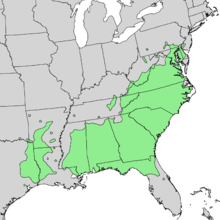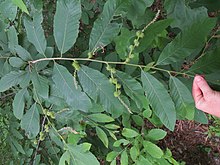| Allegheny chinquapin | |
|---|---|

| |
| Leaves and flowers of Allegheny chinquapin | |
| Conservation status | |
 Least Concern (IUCN 3.1) | |
 Secure (NatureServe) | |
| Scientific classification | |
| Kingdom: | Plantae |
| Clade: | Tracheophytes |
| Clade: | Angiosperms |
| Clade: | Eudicots |
| Clade: | Rosids |
| Order: | Fagales |
| Family: | Fagaceae |
| Genus: | Castanea |
| Species: | C. pumila |
| Binomial name | |
| Castanea pumila Mill. | |

| |
| Natural range | |
| Synonyms | |
List
| |
Castanea pumila, commonly known as the Allegheny chinquapin, American chinquapin (from the Powhatan) or dwarf chestnut, is a species of chestnut native to the southeastern United States. The native range is from Massachusetts and New York to Maryland and extreme southern New Jersey and southeast Pennsylvania south to central Florida, west to eastern Texas, and north to southern Missouri and Kentucky. The plant's habitat is dry sandy and rocky uplands and ridges mixed with oak and hickory to 1000 m elevation. It grows best on well-drained soils in full sun or partial shade.
Description
It is a spreading shrub or small tree, reaching 2–8 m (6 ft 7 in – 26 ft 3 in) in height at maturity. The bark is red- or gray-brown and slightly furrowed into scaly plates. The leaves are simple, alternately arranged, narrowly elliptical or lanceolate, yellow-green above and paler and finely hairy on the underside. Each leaf is 7.5–15 cm (3–5+7⁄8 in) long by 3–5 cm (1+1⁄4–2 in) wide with parallel side veins ending in short pointed teeth. The flowers of this monoecious plant appear in early summer. Male flowers are small and pale yellow to white, borne on erect catkins 10–15 cm (4–6 in) long attached to the base of each leaf. Female flowers are 3 mm (0.12 in) long and are located at the base of some catkins. The fruit is a golden-colored cupule 2–3 cm (3⁄4–1+1⁄4 in) in diameter with many sharp spines, maturing in autumn. Each cupule contains one ovoid shiny dark brown nut that is edible.
A natural hybrid of Castanea pumila and Castanea dentata has been named Castanea × neglecta.
Habitat
| This section includes a list of general references, but it lacks sufficient corresponding inline citations. Please help to improve this section by introducing more precise citations. (September 2024) (Learn how and when to remove this message) |

Allegheny chinquapin occurs in mixed hardwood forests among pine and oak trees on high ridges and slopes that are free from limestone. It grows on black sandy dunes in the Carolinas, but not on frontal dunes. It is also found on well-drained stream terraces, dry pinelands, and disturbed sites such as railroad rights- of-way, power line clearings, fence and hedgerows, pine plantations, and old fields. Allegheny chinquapin is closely related to the American chestnut, Castanea dentata, and both trees can be found in the same habitat. Allegheny chinquapin can be distinguished by its smaller nut (half the size of a chestnut) that is not flattened (chestnuts are flattened on one side). The leaves of the Allegheny chinquapin are smaller than the American chestnut and have less distinct teeth. Allegheny chinquapin, however, is less susceptible to the chestnut blight fungus that devastated the American chestnut. While the chinquapin does blight to some degree, it continues to send out suckers that will produce fruit. Chinquapins are quite vulnerable nevertheless, and there are many reports of heavily diseased and cankered trees.
Uses
John Smith of Jamestown made the first record of the tree and its nuts in 1612, observing its use by the Native Americans. Native Americans made an infusion of chinquapin leaves to relieve headaches and fevers. The bark, leaves, wood, and seed husks of the plant contain tannin. The nuts can be blanched, dried, and rehydrated to be prepared as food. The wood is hard and durable and is sometimes used in fences and fuel, but the plant is too small for the wood to be of commercial importance.
Chinquapins are used in landscapes for the purpose of attracting wildlife. When the base of the plant is cut or wounded at ground level the plant will grow multiple stalks producing a thick cover used by turkeys. The nuts are consumed by squirrels and rabbits while white-tailed deer graze upon the foliage.
References
- IUCN SSC Global Tree Specialist Group & Botanic Gardens Conservation International (BGCI). 2022. Castanea pumila. The IUCN Red List of Threatened Species 2022: e.T138593360A197386578. https://dx.doi.org/10.2305/IUCN.UK.2022-1.RLTS.T138593360A197386578.en. Accessed on 15 November 2022.
- "NatureServe Explorer 2.0 - Castanea pumila, Allegheny Chinquapin". explorer.natureserve.org. Retrieved 6 May 2020.
- "Castanea pumila (L.) Mill". Plants of the World Online. Board of Trustees of the Royal Botanic Gardens, Kew. 2017. Retrieved 28 August 2020.
- "Castanea pumila". North Carolina Extension Gardener Plant Toolbox. NC State University. Retrieved 14 July 2022.
- Little, Elbert L. (1980). The Audubon Society Field Guide to North American Trees: Eastern Region. New York: Knopf. p. 380. ISBN 0-394-50760-6.
- "Castanea × neglecta Dode". Plants of the World Online. Royal Botanical Gardens Kew. Retrieved 12 August 2020.
- Elias, Thomas S.; Dykeman, Peter A. (2009) . Edible Wild Plants: A North American Field Guide to Over 200 Natural Foods. New York: Sterling. p. 234. ISBN 978-1-4027-6715-9. OCLC 244766414.
- "Wildlife Gardening: Chinquapin Tree". Prepper Gardens. Archived from the original on 4 January 2014. Retrieved 23 January 2014.
Further reading
External links
- VT Dendrology – includes pictures of leaves, flowers, and fruit
| Taxon identifiers | |
|---|---|
| Castanea pumila |
|
| Fagus pumila | |